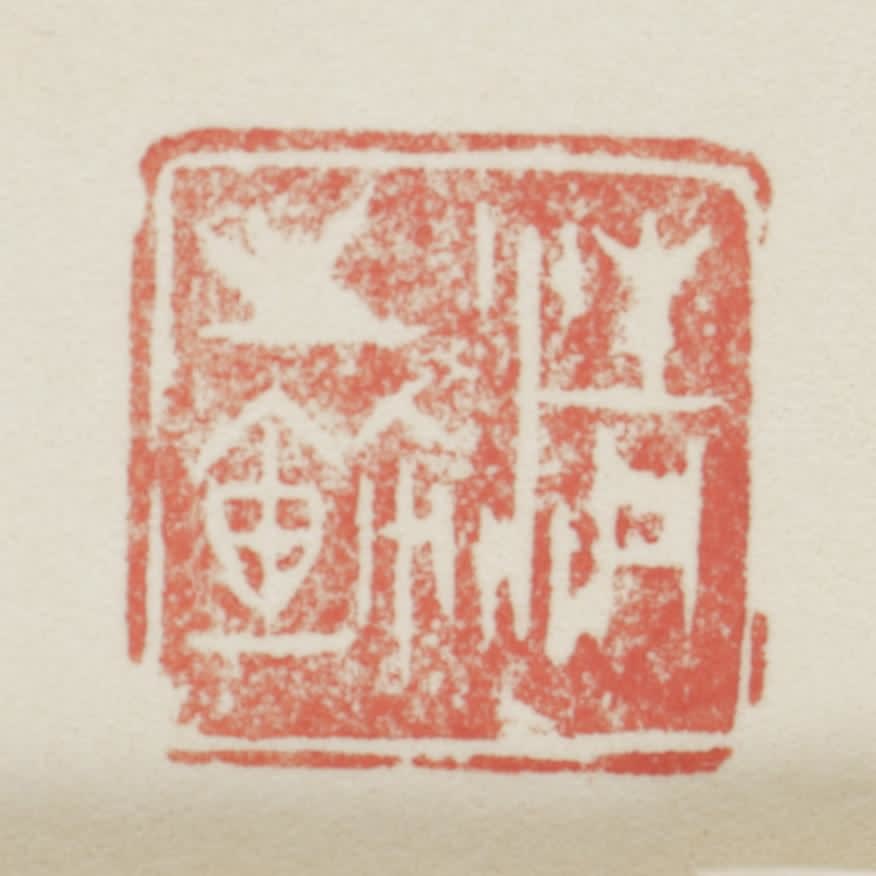Morita Shiryū (1912–1998)
Datsu
Ink on paper, framed
1963
With a label signed by Inada Sousai
Seal: Kiyoshi no ji
41 x 59 cm
43 x 61 cm (overall)
1963
With a label signed by Inada Sousai
Seal: Kiyoshi no ji
41 x 59 cm
43 x 61 cm (overall)
Further images
Literature
Morita Shiryu Catalogue Raisonné: 1952–1998. Uji: Soryusha, 2019.
The Chinese character datsu is written by combining the radical for “flesh” on the left with a component meaning “eliminate” on the right, from the latter of which the character derives its phonetic spelling of datsu. While the original meaning is close to “lose weight,” it also came to signify “take off” or “undress.” According to the artist’s own interpretation of the title, originally written in English, the meaning is “to get rid of / get out of the restrictions of the external world.”
In this work, the “flesh” radical takes up the central and upper left areas of the composition. It is counterbalanced by the phonetic component datsu which fills most of the lower left and for which Morita used a slightly more saturated, heavier tone. He executed the beginning of the first stroke (upper center) with an light and broad leftward-sweeping touch, followed by a near-vertical smaller stroke, then placing four large dots in the center and center right. The final strokes in the lower right rely on more intensely saturated ink. Across the surface, there is a recurrent pattern of what appears like little pockets of air that burst in the process of drying, leaving dot-like white spots. Morita may have used additives to achieve the effect. Maybe such manipulation was also the cause for the ink being more concentrated near the end of the final stroke on the lower right, unlike in most calligraphy where the stroke is most saturated at the beginning and gradually turns lighter as the brush depletes its reservoir. It is an interesting inversion of the usual appearance of ink density.
Datsu was created in 1963, the year when Morita wrote this character the most often. Like the majority of datsu works of that year, it relies on an arrangement with the radical component crowning the character on top. Morita would abandon this idiosyncratic rendering over the course of the next year in favor of an arrangement with the character’s radical on the left juxtaposed to its phonetic component on the right. Perhaps this formal shift reflects a change in Morita’s attitude towards the notion of ridding oneself of the external world.
Morita Shiryu (avant-garde calligrapher; 1912–1998)
Avant-garde calligrapher from Hyogo Prefecture. Like fellow artist Inoue Yuichi, Morita studied under the calligraphy master Ueda Sokyu. He co-founded the avant-garde group Bokujinkai together with Inoue and was the founder and editor of the journal Bokubi (Beauty of Ink), both of which revolutionized traditional Japanese calligraphy and spread knowledge of Japanese avant-garde calligraphy to an international audience. He was posthumously awarded the Medal of Honor with Dark Blue Ribbon.
In this work, the “flesh” radical takes up the central and upper left areas of the composition. It is counterbalanced by the phonetic component datsu which fills most of the lower left and for which Morita used a slightly more saturated, heavier tone. He executed the beginning of the first stroke (upper center) with an light and broad leftward-sweeping touch, followed by a near-vertical smaller stroke, then placing four large dots in the center and center right. The final strokes in the lower right rely on more intensely saturated ink. Across the surface, there is a recurrent pattern of what appears like little pockets of air that burst in the process of drying, leaving dot-like white spots. Morita may have used additives to achieve the effect. Maybe such manipulation was also the cause for the ink being more concentrated near the end of the final stroke on the lower right, unlike in most calligraphy where the stroke is most saturated at the beginning and gradually turns lighter as the brush depletes its reservoir. It is an interesting inversion of the usual appearance of ink density.
Datsu was created in 1963, the year when Morita wrote this character the most often. Like the majority of datsu works of that year, it relies on an arrangement with the radical component crowning the character on top. Morita would abandon this idiosyncratic rendering over the course of the next year in favor of an arrangement with the character’s radical on the left juxtaposed to its phonetic component on the right. Perhaps this formal shift reflects a change in Morita’s attitude towards the notion of ridding oneself of the external world.
Morita Shiryu (avant-garde calligrapher; 1912–1998)
Avant-garde calligrapher from Hyogo Prefecture. Like fellow artist Inoue Yuichi, Morita studied under the calligraphy master Ueda Sokyu. He co-founded the avant-garde group Bokujinkai together with Inoue and was the founder and editor of the journal Bokubi (Beauty of Ink), both of which revolutionized traditional Japanese calligraphy and spread knowledge of Japanese avant-garde calligraphy to an international audience. He was posthumously awarded the Medal of Honor with Dark Blue Ribbon.





